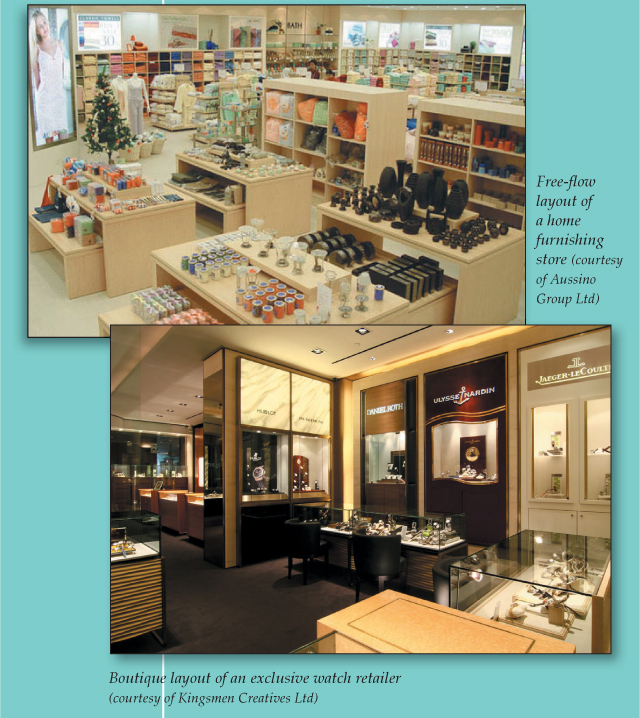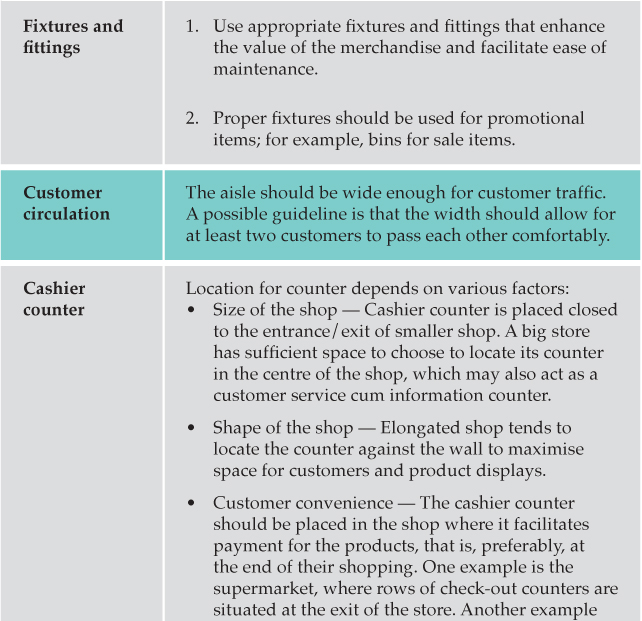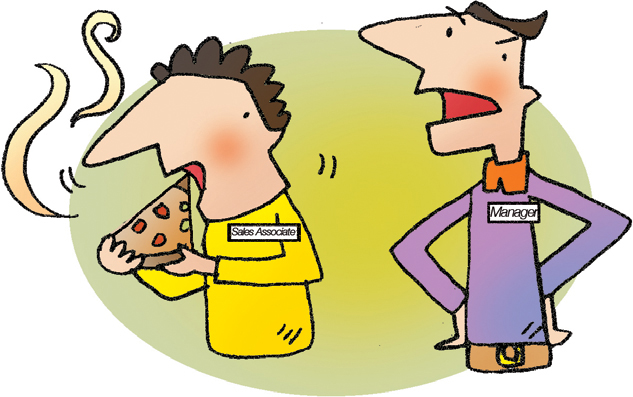Chapter 7. Upkeeping Shop Image

Retailers spruce up their shops’ appearances, stock up the right merchandise and upkeep the facilities in the shop to create the right atmosphere as well as an enjoyable and fuss-free shopping environment for their shoppers.
The objective is to create a positive image. A positive store image helps to:
• Attract shoppers to the shop
• Get them to go inside the shop
• Encourage them to browse
• Encourage them to buy the merchandise/service
“Store Image = Store Personality”
Store image can also be defined as the overall perception shoppers have of the store’s environment. It is the store’s personality.
Perception = Value
Perception is very powerful. Shoppers are more likely to patronise the retailer when they perceive that the shop sells good quality products, the place is clean, and the sales associates are polite and professional. They are also likely to become regular customers. In addition, they feel that the price they pay for the merchandise is worth it, that is, they have the ‘value-for-money’ perception.
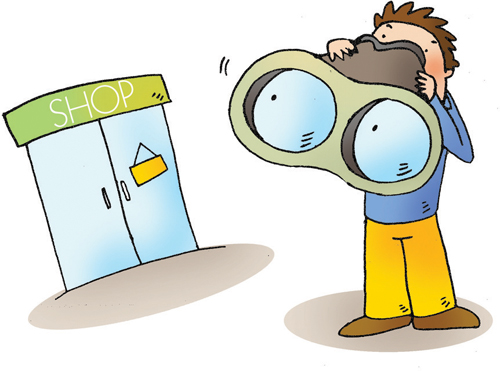
Customers’ perception of a store will determine their patronage.
What exactly constitutes store image? Some factors that affect how shoppers assess the store image are as follows:
• First impression from the outside of the store
• Merchandise displays
• Lighting in the shop
• Quality of products
• Cleanliness in the store
• Last impression at the payment/service counter
• Behind the scenes: Store room and refuse areas
• Staff appearance
• Services rendered by staff
• Complaint handling
This chapter attempts to explain how retailers can play their parts to create and maintain the store image. It includes layout, housekeeping and maintenance.
Shop Layout
The layout of a shop is the arrangement and placement of fixtures, fittings, equipment, merchandise, aisles and non-selling areas such as the checkout, the fitting room and receiving area.
Small retailers have limited shop space, yet customer comfort is still important in attracting sales. With these constraints in mind, there are a few basic factors to be considered when designing the store layout. These factors are not conclusive and retailers need only to consider those relevant to their requirements.


Housekeeping and Maintenance
Housekeeping refers to the general cleaning of the shop. It is carried out daily. Store maintenance refers to the upkeep and repair of the shop. Note that repairs are sometimes subcontracted to qualified technicians. Staff should know the contacts of the relevant technicians or companies in case the need arises. Maintenance is a routine task but may not be carried out daily. Some retailers carry out maintenance periodically, especially for equipment and fixtures such as air-conditioners and security mirrors that do not require daily checks.
This section emphasises the housekeeping of all areas, fixtures, walls, floors, ceilings and lights and the maintenance of equipment such as closed circuit televisions, cash registers, vacuum cleaner, stereo sets, and more. These affect customers perception of the store, the life span of fixtures and equipment, and the operating expenses.
Keeping equipment in good working condition helps to ease the housekeeping tasks and, at the same time, facilitate the selling process.
Front-end tasks
Both housekeeping and maintenance are carried out at the following front-end areas.
1. Entrance
• Areas immediately outside and inside the entrance of the shop must be clear of dirt.
• If a welcome mat is placed at the entrance, make sure that it is clean and in good condition.
2. Doors
• If doors are used, make sure that they are clean. Fingerprints all over the doors do not convey a good store image.
• Refrain from pasting too many posters and notices on the doors so that shoppers can see the interior of the shop.
• Remove old and unwanted posters regularly.
3. Signages outside and inside the shop
• Clean the signages.
• Ensure that display signs are properly placed and in an upright position.
• Double-check that information on the display signs are correct and up-to-date.
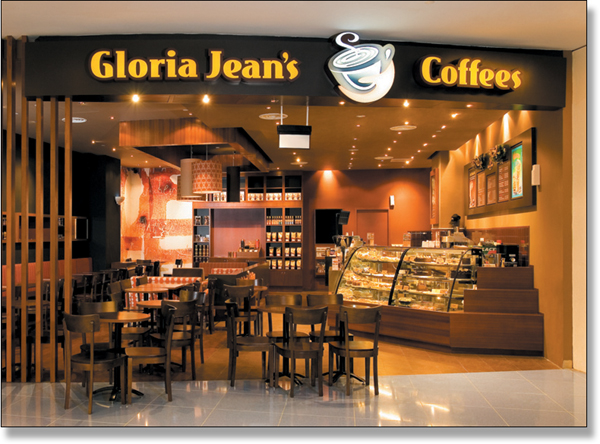
Store sign outside — Gloria Jean’s
(courtesy of Kingsmen Creatives Ltd)
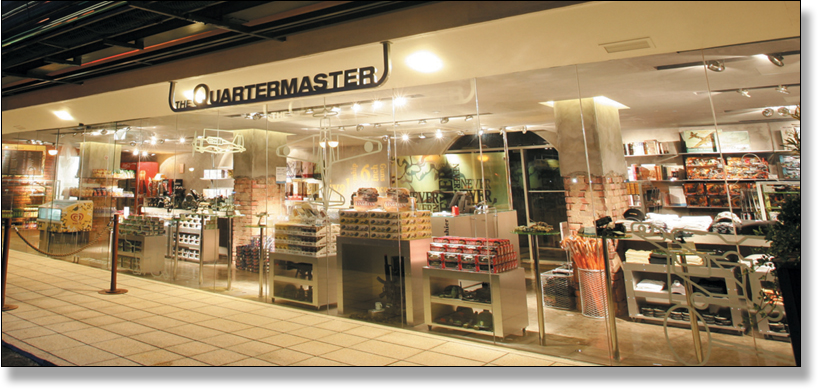
Display window — Quartermaster window
(courtesy of Kingsmen Creatives Ltd)
• Clean and wipe the windows. Similar to doors, fingerprints on windows are not desirable.
• Ensure that displays are in good condition. There should be no broken props, untidy merchandise, cobwebs, etc.
5. Aisles and floor
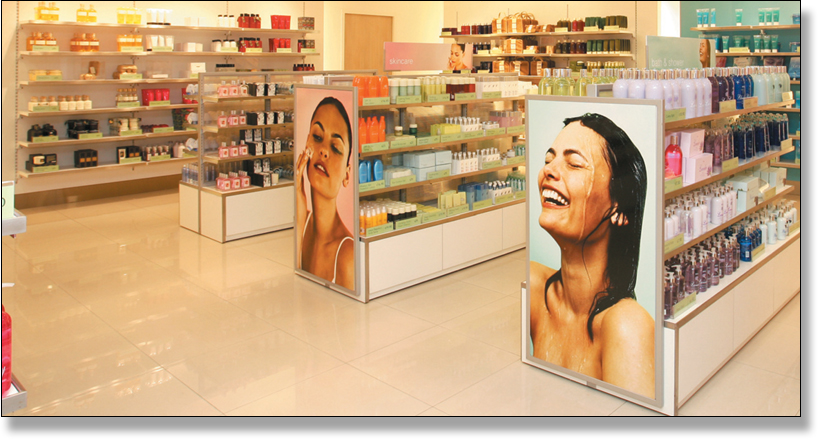
Aisles — Marks & Spencer, Centrepoint
(courtesy of Kingsmen Creatives Ltd)
• Do not clutter aisles and floor with cartons or any devices. Remove them immediately after receiving stock or after use.
• Mop or vacuum aisles and floor.

Check-out counter
(courtesy of Aussino Group Ltd)
• The actual cashier counter and the areas around and behind the counter have to be neat and presentable.
• Do not clutter the counter with cartons, boxes, extra shopping bags, wrapping materials and outdated notices.
• If you want to display add-on merchandise on the counter, select a maximum of three appropriate products only.
• The displayed merchandise should be:
– Small items
– Festive and/or seasonal products
– Impulse products
– Reasonably priced items
– Link-products to the majority of purchases
• Promotional signages can be placed on the counter to attract and encourage customers to make the purchase.
• Cracks on walls are unsightly and can affect the overall image of the shop.
• Inform the manager or get someone to rectify the cracks as soon as possible.
• Remove cobwebs and dirt that usually accumulate at the wall corners.
8. Ceiling
• Check that there is no water seepage or leakage on the ceiling.
• Make sure that props or display cards hanging from the ceiling do not damage the ceiling.
• If there is any problem, inform the manager or get someone to rectify it.
9. Lights
• Change light bulbs when they are damaged. A dim or dark area can result in accidents.
10. Air-conditioners
• Adjust the temperature of the shop to a comfortable level. Temperatures that are too high or too low are not conducive for shopping.
• Check for water leakage.
• When an air-conditioner is not working, inform the manager or get it repaired immediately.
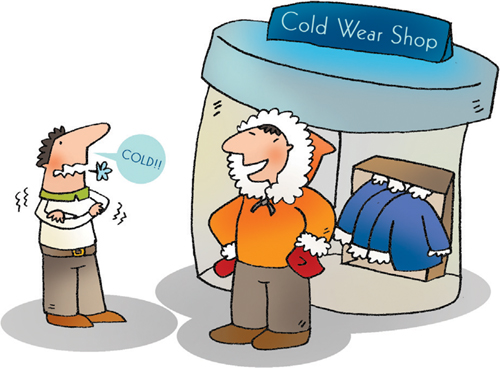
Do not let your customers freeze by setting the temperature too low! (even if you hope that they would buy your goods)
11. Cash registers and/or Point-Of-Sale (POS) System
• Wipe clean the cash register and Point-Of-Sale System.
• Do not paste unnecessary notices on the machines.
• If the machines malfunction, contact the vendors for services.
12. Sound system like stereo sets, speakers, etc.
• Gently wipe the systems.
• Pay attention to the sound quality. Poor sound quality affects the mood of shoppers and staff.
• When the system is damaged, get it repaired.
13. Fixtures such as shelves, mannequins, showcases, display, bins, etc.
• Check that the fixtures are in good condition.
• Clean the fixtures while doing merchandise housekeeping.
• Arrange to replace damaged or unsuitable fixtures.
14. Tools such as vacuum cleaners, ladders, mops, etc.
• Learn the proper ways to handle these tools. This will cut down damage and the need to purchase new ones.
• Always place the tools back in their origin storage location after use so that staff can find them when they need to use them.
15. Equipment such as closed circuit televisions, mirrors, etc.
• Dust the equipment.
• Check that they are in good working condition.
• If any equipment is damaged, report to the vendors for repairs.
Back-end Tasks
Back-end areas are areas where customers do not have access. They include the stock room, restroom, receiving areas (for retailers with back-end receiving) and the refuse area.
Customers may not see the back-end areas but it is still important to follow good housekeeping and maintenance practices in these areas.
Failure to do so may result in problems such as insect infestation, damaged merchandise and health hazards.
Here are some housekeeping and maintenance guidelines for back-end areas.
1. Use of space for the stock room
• Maximise the use of wall areas.
• Full use of floor-to-ceiling height for shelving.
• Merchandise should be kept off the floor so the floor can be swept and mopped. That is, there should be a gap between the lowest shelves and the merchandise.
• Ensure sufficient aisle width for trolley and bulky items.
• Leave adequate space for handling, checking and unpacking of goods.
2. Stock arrangement
• Faster-selling items should be placed nearest to the sales area.
• Products should be stacked so that they follow the same pattern and layout of the store.
• Products should be kept in outer packs or cases, each with its contents properly labelled.
• Old stock should be moved to the sales area before the new stock.
• Food should be stored in containers and covered.
• Cold food should be kept at or below 4.4 degrees Celsius to 4.5 degrees Celsius.
• Hot food must be kept at or above 60 degrees Celsius.
• The danger zone for food is between 4.4 degrees Celsius and 60 degrees Celsius.
4. Security
• All products should be placed in visible positions.
• Ensure adequate lighting.
• Secure high – value items with some form of lock or cage.
5. Cleaning materials and equipment
• Cleaning materials and equipment should be stored away from merchandise, especially food items.
• They should be clearly labelled.
6. Refuse area
• Refuse should always be kept in tightly closed containers.
• Rubbish has to be disposed of daily. If necessary, it has to be cleared more frequently in between the day.
• The area around the refuse containers should be free of litter.
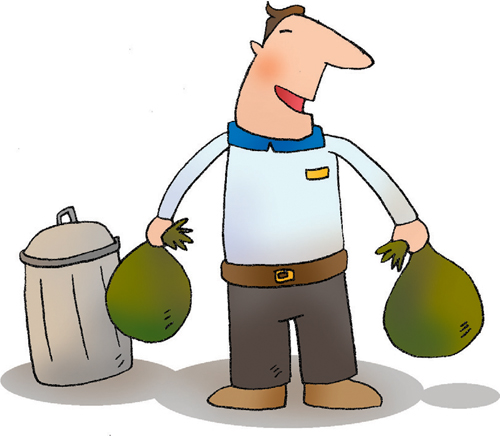
• A clean restroom enhances the shopping experience. It is especially important when the retailer sells food items or when food preparation is part of the sales associates’ job.
• It is better not to have any restroom than to have restrooms that are dirty and untidy.
Schedules for Housekeeping and Maintenance
Housekeeping and maintenance closely affect each other. For example, proper housekeeping of shop areas and fixtures will extend their usefulness, and thus, cut down on the need for repairs. On the other hand, constant maintenance of the fixtures and equipment helps to make general cleaning of these areas and items easier and faster.
Most importantly, both housekeeping and maintenance facilitate the selling process.
Basically, there are six pointers that can help the staff to schedule, assign and carry out housekeeping and maintenance tasks in the shop. In this way, no areas and items in the shop will be neglected.

Here are two examples of the housekeeping and maintenance schedule of a typical small retailer.
EXAMPLE 1: HOUSEKEEPING ROUTINE
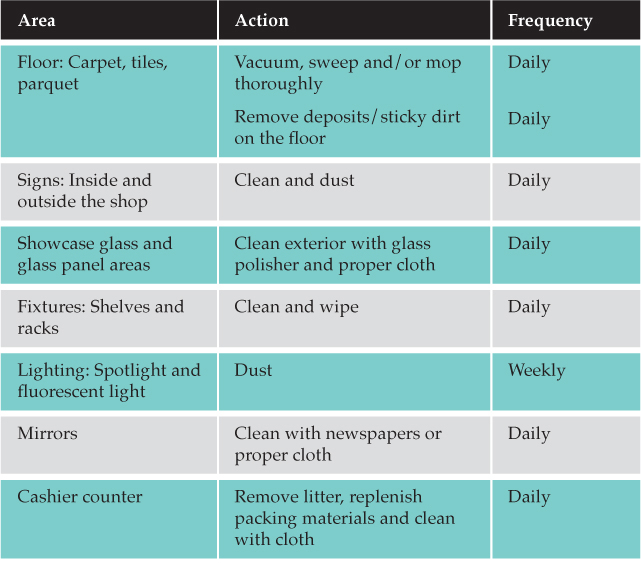

EXAMPLE 2: MAINTENANCE ROUTINE FOR COMMON EQUIPMENT

Conclusion
Treat the shop like your house... you, the retailer is the host, and customers are the invited guests. Keep your place clean and neat and your guests will enjoy their stay!


